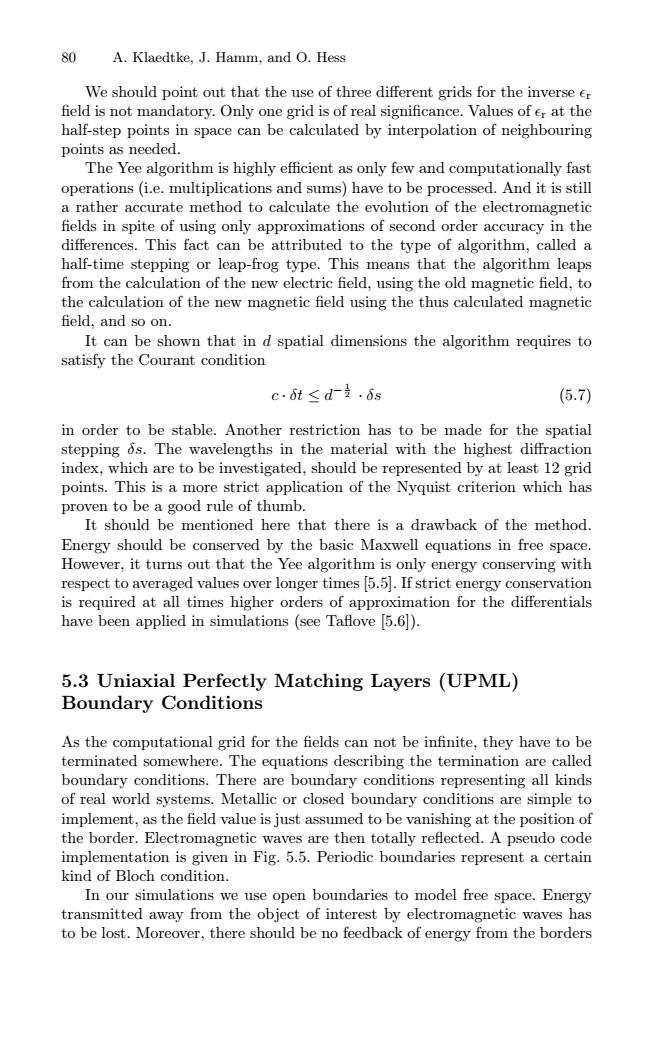正在加载图片...

80 A.Klaedtke,J.Hamm,and O.Hess We should point out that the use of three different grids for the inverse er field is not mandatory.Only one grid is of real significance.Values of er at the half-step points in space can be calculated by interpolation of neighbouring points as needed. The Yee algorithm is highly efficient as only few and computationally fast operations (i.e.multiplications and sums)have to be processed.And it is still a rather accurate method to calculate the evolution of the electromagnetic fields in spite of using only approximations of second order accuracy in the differences.This fact can be attributed to the type of algorithm,called a half-time stepping or leap-frog type.This means that the algorithm leaps from the calculation of the new electric field,using the old magnetic field,to the calculation of the new magnetic field using the thus calculated magnetic field,and so on. It can be shown that in d spatial dimensions the algorithm requires to satisfy the Courant condition c.6t≤d支.6s (5.7) in order to be stable.Another restriction has to be made for the spatial stepping 6s.The wavelengths in the material with the highest diffraction index,which are to be investigated,should be represented by at least 12 grid points.This is a more strict application of the Nyquist criterion which has proven to be a good rule of thumb. It should be mentioned here that there is a drawback of the method. Energy should be conserved by the basic Maxwell equations in free space. However,it turns out that the Yee algorithm is only energy conserving with respect to averaged values over longer times 5.5.If strict energy conservation is required at all times higher orders of approximation for the differentials have been applied in simulations (see Taflove 5.6). 5.3 Uniaxial Perfectly Matching Layers (UPML) Boundary Conditions As the computational grid for the fields can not be infinite,they have to be terminated somewhere.The equations describing the termination are called boundary conditions.There are boundary conditions representing all kinds of real world systems.Metallic or closed boundary conditions are simple to implement,as the field value is just assumed to be vanishing at the position of the border.Electromagnetic waves are then totally reflected.A pseudo code implementation is given in Fig.5.5.Periodic boundaries represent a certain kind of Bloch condition. In our simulations we use open boundaries to model free space.Energy transmitted away from the object of interest by electromagnetic waves has to be lost.Moreover,there should be no feedback of energy from the borders80 A. Klaedtke, J. Hamm, and O. Hess We should point out that the use of three different grids for the inverse r field is not mandatory. Only one grid is of real significance. Values of r at the half-step points in space can be calculated by interpolation of neighbouring points as needed. The Yee algorithm is highly efficient as only few and computationally fast operations (i.e. multiplications and sums) have to be processed. And it is still a rather accurate method to calculate the evolution of the electromagnetic fields in spite of using only approximations of second order accuracy in the differences. This fact can be attributed to the type of algorithm, called a half-time stepping or leap-frog type. This means that the algorithm leaps from the calculation of the new electric field, using the old magnetic field, to the calculation of the new magnetic field using the thus calculated magnetic field, and so on. It can be shown that in d spatial dimensions the algorithm requires to satisfy the Courant condition c · δt ≤ d− 1 2 · δs (5.7) in order to be stable. Another restriction has to be made for the spatial stepping δs. The wavelengths in the material with the highest diffraction index, which are to be investigated, should be represented by at least 12 grid points. This is a more strict application of the Nyquist criterion which has proven to be a good rule of thumb. It should be mentioned here that there is a drawback of the method. Energy should be conserved by the basic Maxwell equations in free space. However, it turns out that the Yee algorithm is only energy conserving with respect to averaged values over longer times [5.5]. If strict energy conservation is required at all times higher orders of approximation for the differentials have been applied in simulations (see Taflove [5.6]). 5.3 Uniaxial Perfectly Matching Layers (UPML) Boundary Conditions As the computational grid for the fields can not be infinite, they have to be terminated somewhere. The equations describing the termination are called boundary conditions. There are boundary conditions representing all kinds of real world systems. Metallic or closed boundary conditions are simple to implement, as the field value is just assumed to be vanishing at the position of the border. Electromagnetic waves are then totally reflected. A pseudo code implementation is given in Fig. 5.5. Periodic boundaries represent a certain kind of Bloch condition. In our simulations we use open boundaries to model free space. Energy transmitted away from the object of interest by electromagnetic waves has to be lost. Moreover, there should be no feedback of energy from the borders